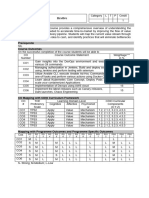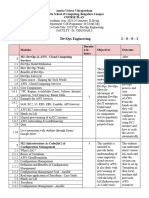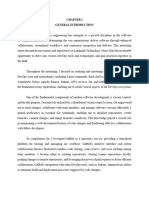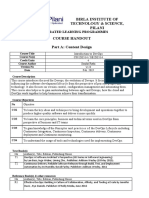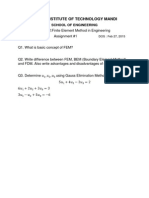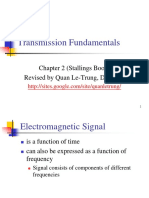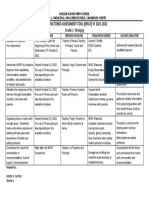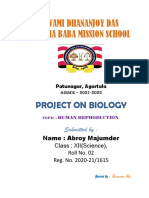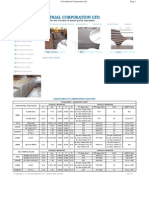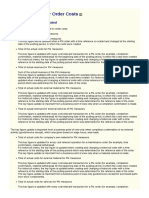DevOps LessonPlan Detailed Ver
Uploaded by
mulimaniprachiDevOps LessonPlan Detailed Ver
Uploaded by
mulimaniprachiSCHOOL OF COMPUTER SCIENCE AND ENGINEERING
FMTH0301/Rev.5.3
Course Plan
Semester: 6 Year: 2023-24
Program: Bachelor of Engineering
Course Title: DevOps Course Code: 23ECSE310
L-T-P: 1-0-2 Credits: 3 Contact Hrs: 5 hrs/week
Total Contact hrs: 70 hrs Duration of ESA: 3 hrs
ISA Marks: 80 ESA Marks: 20
Lesson Plan Author: Dr. Dattaprasad A. Torse, Dr. Rajashri Khanai Date: 22/02/2024
Checked By: Dr. Padmashri Desai Date: /02/2024
Prerequisites: Basic understanding of software development, familiarity with Operating Systems and networking, basic knowledge of security and compliance and basic programming skills are
essential.
Course Outcomes (COs):
At the end of the course the student should be able to:
1. Demonstrate significance of DevOps and its Relationship with Cloud.
2. Explain platforms and Version Control Systems with Git.
3. Create and Configure CI/CD Build Jobs using Jenkins.
4. Create and Manage Docker Containers.
5. Develop continuous monitoring using Prometheus and Grafana.
Course Articulation Matrix: Mapping of Course Outcomes (COs) with Program Outcomes (POs)
Course Title: DevOps Semester: 6
Course Code: 23ECSE310 Year: 2023-24
Course Outcomes (COs) / Program Outcomes (POs) 1 2 3 4 5 6 7 8 9 10 11 12 13 14
1. Demonstrate significance of DevOps and its Relationship with Cloud. H M
2. Explain platforms and Version Control Systems with Git. H H
3. Create and Configure CI/CD Build Jobs using Jenkins. H H
4. Create and Manage Docker Containers. H H
5. Develop and analyze continuous monitoring using Prometheus and Grafana. H H
Degree of compliance L: Low M: Medium H: High
Competency addressed in the Course and corresponding Performance Indicators
Competency Performance Indicators
1.6 Demonstrate competence in specialized engineering knowledge to the
1.6.1 Apply engineering fundamentals
program
1.7 Demonstrate competence in specialized engineering knowledge to the 1.7.1 Apply theory and principles of computer science
Powered by www.ioncudos.com Page 1 of 9.
SCHOOL OF COMPUTER SCIENCE AND ENGINEERING
program and engineering to solve an engineering problem
2.1 Demonstrate an ability to identify and formulate complex engineering
2.1.4 Use processes /techniques for problem analysis
problem
4.5 Demonstrate an ability to design experiments to solve open-ended problems 4.5.1 Design and develop appropriate procedures/methodologies based on the study objectives
5.4 Demonstrate an ability to identify/create modern engineering tools,
5.4.2 Create/adapt/modify/extend tools and techniques to solve engineering problems
techniques, and resources
Eg: 1.2.3: Represents Program Outcome ‘1’, Competency ‘2’ and Performance Indicators ‘3’.
Course Content
Course Code: 23ECSE310 Course Title: DevOps
L-T-P: 1-0-2 Credits: 3 Contact Hrs: 5 Hrs/Week
ISA Marks: 80 ESA Marks: 20 Total Marks: 100
Teaching Hrs: 70 Lab Slots: 14 Exam Duration: 3 Hrs
Unit –I
Introduction to DevOps and Continuous Delivery
Introducing DevOps, The Agile wheel of wheels, DevOps and ITIL, Infrastructure As A Code, Continuous Integration and Development.
1
4 hrs
Linux and Automation
User Management, Package Management, Networking, Shell Variable, Decision making, Shell test conditions, Shell loops, Redirectors, Exit status.
AWS Cloud
2
Introduction to cloud computing & AWS, Regions & AZ’s, EC2, Elastic Block store (EBS), EFS, Auto scaling, Load balancing & Route 53, VPC, Object 2 hrs
storage(S3), AWS Lambda & CLI.
Unit –II
Version Control with Git
Source Code Management (SCM), Git branching and merging, Git Overview, Creating pull request, Code Review, Merging changes, Create a repo and push code
3
on GibHub / Bitbucket. 4 hrs
Continues Integration using Jenkins
Introduction, Setup & Launch Jenkins, Creating first job, Notifications, CICD pipeline, Build Pipeline plugin in Jenkins.
Configuration Management using Ansible
4
2 hrs
Introduction, Local infrastructure development, Ad-Hoc commands, Playbooks, Playbooks organization – Roles & Includes, Inventories, Ansible for AWS.
Unit –III
5 Containers 2 hrs
Containers Concepts, Container Vs Virtual Machine, Docker installation, Managing Container with Docker Commands, Building your own docker images.
Continues Monitoring using Prometheus and Grafana
Powered by www.ioncudos.com Page 2 of 9.
SCHOOL OF COMPUTER SCIENCE AND ENGINEERING
What is continues monitoring, Goals, Types of Continues monitoring, Prometheus installation, Grafana installation, Integration of Prometheus and Grafana.
Text Books:
1. Joakim Verona, “Practical DevOps.” Packt Publishing Ltd, Feb. 2016, ISBN: 9781785882876
2. Jeff Geerling, “Ansible for DevOps: Server and configuration management for humans.” Leanpub, 2015.
3. John Ferguson, “Jenkins: The Definitive Guide” Smart Publisher: O'Reilly Media, Release Date: June 2016.
Reference Books:
1. Jennifer Davis, Ryn Daniels, “Effective DevOps, Building a Culture of Collaboration, Affinity, and Tooling at Scale”, Publisher: O'Reilly Media, Release Date: June 2016.
2. Gene Kim, Patrick Debois, John Willis, Jez Humble, “The DevOps Handbook: How to Create World-Class Speed, Reliability, and Security in Technology Organizations”, IT Re-
volution Press, 2016.
Evaluation Scheme
Assessment Weightage in Marks
Review 30
Day-to-Day Evaluation 10
ISA Scheme
Quiz (Interview Questions) 20
(80 Marks)
Certification Courses from Infosys Springboard 20
ISA Total 80
ESA Scheme
Lab Exam 20
(20 Marks)
Total 100
Course Unitization for ISA and ESA
No. of Questions in No. of Questions
No. of Questions Review
Topics / Chapters Teaching Credits Activity in ESA
Unit I
Introduction to DevOps and Continuous Delivery 10 1 1
Experiments /
1
Linux and Automation 10 1
Exercises
1
Introduction to AWS cloud 10 1
Unit II
Version Control with Git 10 1 1
1 Experiments /
Continues Integration using Jenkins 10 1
Exercises
1
Configuration Management using Ansible 10 1
Unit III
Containers 10 1 1
Quiz
1
Continues Monitoring using Prometheus and Grafana 10 1
Powered by www.ioncudos.com Page 3 of 9.
SCHOOL OF COMPUTER SCIENCE AND ENGINEERING
Date: 24/02/2024 Co-Ordinator, SoCSE
Course Assessment Plan
Course Title: DevOps Code:21ECSE310
Assessment Methods
Weightage in
Course outcomes (COs) Day-to day
assessment Review Quiz Certification courses ESA
evaluation
1. Demonstrate significance of DevOps and its Relationship with
15%
Cloud.
2. Explain platforms and Version Control Systems with Git. 15%
3. Create and Configure CI/CD Build Jobs using Jenkins. 10% √
4. Create and Manage Docker Containers. 40%
5. Develop and analyze continuous monitoring using Prometheus
20%
and Grafana.
Weightage 30% 10% 20% 20% 20%
DevOps Lab Schedule
SI. No. Experiments Number of slots
Exploring AWS cloud services
1. 2
Exploring Linux commands for automation on AWS cloud server
Exploring Git Commands through Collaborative coding.
2. 2
Implement GitHub Operations
Applying CI/CD Principles to Web Development
3. 2
Using Jenkins, Git, and Local HTTP Server
Exploring Containerization and Application
Deployment with Docker
4. 4
Applying CI/CD Principles to Web Development
Create the GitHub A/C to demonstrate CI/CD pipeline using Cloud Platform.
5. Certification Courses: Infosys Springboard 4
DevOps Foundation Certification (1 hr)
TechA DevOps Engineer Certification (1 hr)
AWS DevOps Engineer Certification 2022 (5 hr 12 mins)
TechA Git Foundation Certification (1 hr)
Powered by www.ioncudos.com Page 4 of 9.
SCHOOL OF COMPUTER SCIENCE AND ENGINEERING
TechA Ansible Foundation Certification (1 hr)
TechA Docker Apprenticeship Certification (1 hr)
Course Experiments Rubrics
Focus Marks BL PI
Git commands, Linux server on cloud 7 L2 5.4.2
AWS cloud platform 7 L2 2.1.4
CI using Jenkins 6 L3 4.5.1
Configuration management using Ansible 6 L3 4.5.1
Demonstration with technical details of the projects 4 L3 5.4.2
Chapter Wise Plan
Course Code and Title: 23ECSE310 DevOps
Chapter Number and Title: Introduction to DevOps and Continuous Delivery Planned Hours: 4 hrs
Learning Outcomes: -
At the end of the topic the student should be able to:
Topic Learning Outcomes COs BL CA Code
1. Introduce to DevOps and Continuous Delivery: Introducing DevOps 1 L2 1.6
2. Understand the Agile wheel of wheels, DevOps and ITIL 1 L2 1.6
3. Explain Infrastructure As a Code 1 L2 1.6
4. Understand Continuous Integration and Development. 1 L2 1.6
5. Understand Linux commands for user management, package management, and networking 2 L2 1.6
6. Develop scripts using shell Variable, decision making, 2 L3 1.7
7. Understand shell test conditions, Shell loops, and redirectors 2 L3 1.7
Review Questions UNIT-1 Chapter-1
Sl.No. - Questions TLOs BL PI Code
1. Examine the growth of software development methodologies 1 L2 1.6.1
2. Illustrate the concept of Infrastructure as Code (IaC) with an example. 1 L2 1.6.1
Powered by www.ioncudos.com Page 5 of 9.
SCHOOL OF COMPUTER SCIENCE AND ENGINEERING
3. Demonstrate the purpose of continuous monitoring in DevOps? 1 L2 1.6.1
4. Explain how DevOps and Information Technology Infrastructure Library can coexist to deliver effective results. 1 L2 1.6.1
5. Explain the agile wheel of wheels and mention some examples of when DevOps can benefit Agile cycles 1 L2 1.6.1
6. Explain steps in user management in Linux. 2 L2 2.1.4
7. Explain steps in package management is Linux. 2 L2 2.1.4
8. List the operators of each type, with short description for each, and the syntax of usage with example for Linus shell test conditions.
2 L2 2.1.4
9. Explain the steps to loop in Bash | Linux /Shell Script | Automation. 2 L3 1.4.1
10. How to manipulate files with shell redirection and pipelines in Linux. 2 L3 1.4.1
Laboratory Experiment
Sl.No. - Questions TLOs BL PI Code
1 L2 2.1.4
1. Familiarize students with essential Git concepts and commands, enabling them to effectively use Git for version control and collaboration.
2. Introduction of Linux Operation System and installing pre-requisite Software’s (SSH Tools and FTP Tools) in Desktop/Laptop.
2 L2 2.1.4
3. Experiment on Linux File/Directory structure and Linux Commands.
At Learning Outcomes: -
At the end of the topic the student should be able to:
Topic Learning Outcomes COs BL CA Code
1. Understand cloud computing & AWS, Regions & AZ’s, 2 L2 1.6
2. Understand EC2, EBS, EFS, Auto scaling, Load balancing & Route 53, VPC, 2 L2 1.6
3. Create Linus server on AWS cloud and store objects in S3, 2 L3 1.6
4. Monitor IAM & cloudwatch, and database services, on AWS Lambda & CLI 2 L3 1.6
Review Questions UNIT-1 Chapter-2
Sl.No. - Questions TLOs BL PI Code
2 L2 2.1.4
1. What is Amazon route 53 and How does Amazon Route 53 provide high availability and low latency?
2. What is the difference between using the local instance store and Amazon Elastic Block Store (Amazon EBS) for the root device? 2 L2 2.1.4
3. What is Amazon EC2 Auto Scaling? When should one use Amazon EC2 Auto Scaling vs. AWS Auto Scaling? 2 L2 2.1.4
4. What is AWS Identity and Access Management (IAM)? How to get started with IAM in Linux server system? 2 L3 1.4.1
5. What is CLI and What are the use cases of a CLI? 2 L3 1.4.1
Powered by www.ioncudos.com Page 6 of 9.
SCHOOL OF COMPUTER SCIENCE AND ENGINEERING
Laboratory Experiment
Sl.No. - Questions TLOs BL PI Code
1. Create an account in AWS,
2 L32 2.1.4
2. Create an EC2 Instance in AWS and connect to the Linux server using SSH.
Learning Outcomes:-
At the end of the topic the student should be able to:
Topic Learning Outcomes COs BL CA Code
1. Introduce to Source Code Management (SCM), and understand Git branching and merging, 2 L2 2.1
2. Create Git pull request, review code, and merge changes 2 L3 2.1
3. Create a repo and push code on GibHub / Bitbucket 2 L3 2.1
4. Create first job using Jenkins, 3 L2 2.1
5. Schedule a job using Poll SCM and distributed architecture in Jenkins, 3 L3 2.1
6. Adding Linux slave to Jenkins, master build pipeline plugin in Jenkins 3 L3 2.1
Review Questions UNIT-2 Chapter-3
Sl.No. - Questions TLOs BL PI Code
1. What is Git and why is it important in software development? 2 L2 2.1.4
2. Explain the difference between Git and GitHub. How does Git handle version control? 2 L2 2.1.4
3. How to create a new Git repository and clone it to your local machine? What is the difference between a Git branch and a tag? 2 L2 2.1.4
4. Discuss the Git workflow for a team of developers. How to resolve a Git conflict when merging branches? 2 L3 1.4.1
5. How to Create a repo and push code on GibHub / Bitbucket. 2 L3 1.4.1
6. What is Jenkins? What are steps executed by Jenkins? 1 L2 2.1.4
7. Explain the significance of CI/CD in the context of web development. How does it benefit the development process and end-users? 1 L2 2.1.4
8. Discuss the role of version control in CI/CD. How does Git facilitate
1 L2 2.1.4
collaborative web development and CI/CD automation?
9. Explain how a Jenkins file is typically used in a Jenkins-based CI/CD pipeline. What are the benefits of defining pipeline stages in code? 2 L3 1.4.1
Laboratory Experiment
Sl.No. - Questions TLOs BL PI Code
1. Explore Git and Github commands through collaborative coding.
2. Implementing Github operations using Git. 2 L2 2.1.4
3. Git Labs & Exercise
Powered by www.ioncudos.com Page 7 of 9.
SCHOOL OF COMPUTER SCIENCE AND ENGINEERING
4. Applying CI/CD Principles to Web Development Using Jenkins, Git, and Local HTTP Server 1 L2 2.1.4
Learning Outcomes: -
At the end of the topic the student should be able to:
Topic Learning Outcomes COs BL CA Code
1. Understand local infrastructure development and Ad-Hoc commands, 4 L2 2.1
1. Understand ansible for AWS 4 L3 2.1
Review Questions UNIT-2 Chapter-4
Sl. No. - Questions TLOs BL PI Code
1. Explain Ansible workflow with a neat diagram. 4 L2 2.1.4
2. Explain Ansible architecture with a neat diagram. 4 L2 2.1.4
3. Why use ansible ad hoc commands? Demonstrate use of ad-hoc commands for use cases of rebooting servers and managing files and
4 L2 2.1.4
packages.
4. Explain ansible CLI with example. 4 L3 2.1.4
5. Illustrate steps in running Ansible playbooks using EC2 systems manager run command and state manager 4 L3 5.4.2
Laboratory Experiment
Sl. No. - Questions TLOs BL PI Code
1. Experiment on Jenkins directory structure and backup. 1 L2 2.1.4
Learning Outcomes:-
At the end of the topic the student should be able to:
Topic Learning Outcomes COs BL CA Code
1. Install and manage container with docker commands, 4 L3 2.1
2. Develop networking inside single docker container 4 L3 5.4
3. Understand continues monitoring, and types of continues monitoring, 5 L2 1.6
4. Prometheus installation, Grafana installation, Integration of Prometheus and Grafana, 5 L3 1.6
Review Questions UNIT-3 Chapter-5
Powered by www.ioncudos.com Page 8 of 9.
SCHOOL OF COMPUTER SCIENCE AND ENGINEERING
Sl. No. - Questions TLOs BL PI Code
1. Discuss the key components of a container. What are images and containers in the context of containerization?
4 L2 2.1.4
2. What is Docker, and how does it contribute to containerization? Explain the role of Docker in building, running, and managing con -
4 L2 2.1.4
tainers.
3. Compare and contrast containerization platforms like Docker, container. What are their respective strengths and weaknesses?
4 L3 1.4.1
4. Explain the process of creating a Docker image. What is a Dockerfile, and how does it help in image creation? 4 L3 1.4.1
5. What is Prometheus? With a neat block diagram explain the architecture of Prometheus. 5 L2 2.1.4
6. What is Prometheus Node Exporter? Explain the steps to deploy the Node Exporter on Kubernetes. 5 L2 2.1.4
7. How to monitor Linux host metrics with the node exporter? 5 L2 2.1.4
8. Explain various Patterns in System Monitoring. 5 L3 1.4.1
Laboratory Experiment
Sl. No. - Questions TLOs BL PI Code
1. Exploring Containerization and Application Deployment with Docker. 4 L2 2.1.4
2. Develop a simple containerized application using Docker and automate the process of running containerized application using Prometheus and
5 L3 5.4.2
Graphana.
Powered by www.ioncudos.com Page 9 of 9.
You might also like
- 23sdcs13a 23sdcs13r Cicd Cloud Devops Lab WorkbookNo ratings yet23sdcs13a 23sdcs13r Cicd Cloud Devops Lab Workbook115 pages
- CSE Semester 06 22CS910 DevOps - Unit INo ratings yetCSE Semester 06 22CS910 DevOps - Unit I84 pages
- CSE Semester 06 22CS910 DevOps - Unit IIINo ratings yetCSE Semester 06 22CS910 DevOps - Unit III58 pages
- CSE Semester 06 22CS910 DevOps - Unit IINo ratings yetCSE Semester 06 22CS910 DevOps - Unit II67 pages
- 21CS726 Technology Elective - DevOps Engineering - CourseplanNo ratings yet21CS726 Technology Elective - DevOps Engineering - Courseplan5 pages
- Lfs162X - Introduction To Site Reliability Engineering and DevopsNo ratings yetLfs162X - Introduction To Site Reliability Engineering and Devops9 pages
- Syllabus BTech Cloud Automation and DevOps DR SarikaNo ratings yetSyllabus BTech Cloud Automation and DevOps DR Sarika4 pages
- 3 CCS342 DEVOPS PRACTICE Observation - Index & ExperimentsNo ratings yet3 CCS342 DEVOPS PRACTICE Observation - Index & Experiments93 pages
- ESL Brains Theyre My Friends To Be Positive SV 7941 2No ratings yetESL Brains Theyre My Friends To Be Positive SV 7941 25 pages
- Top 61 MCQ On Literary Theory and Criticism100% (13)Top 61 MCQ On Literary Theory and Criticism18 pages
- Understanding Solar Plant Design ParametersSolar Irradiance, Tilt Angle, Azimuth, Efficiency Factors and Shading AnalysisNo ratings yetUnderstanding Solar Plant Design ParametersSolar Irradiance, Tilt Angle, Azimuth, Efficiency Factors and Shading Analysis46 pages
- Catalog Number Description Locking Ring Thrust Washer Trim Washer Panel GasketNo ratings yetCatalog Number Description Locking Ring Thrust Washer Trim Washer Panel Gasket27 pages
- Solid Waste Landfilling Concepts Processes Technology 1st Edition HQ File Fast AccessNo ratings yetSolid Waste Landfilling Concepts Processes Technology 1st Edition HQ File Fast Access315 pages
- Lecture - 01b - Fundamentals in Wireless Transmissions StallingsNo ratings yetLecture - 01b - Fundamentals in Wireless Transmissions Stallings37 pages
- Step-By-Step Configuration of MRP Types in Sap PPNo ratings yetStep-By-Step Configuration of MRP Types in Sap PP3 pages
- Art Journal 45 3 Video The Reflexive Medium PDFNo ratings yetArt Journal 45 3 Video The Reflexive Medium PDF85 pages
- An Analysis of The Wood Sugar Assay Using HPLC PDFNo ratings yetAn Analysis of The Wood Sugar Assay Using HPLC PDF7 pages
- Mfat Action Plan Implementation Sy 2021-2022No ratings yetMfat Action Plan Implementation Sy 2021-20221 page
- Situating Uncertainty in Clinical DecisiNo ratings yetSituating Uncertainty in Clinical Decisi7 pages
- Foundation Fieldbus Installation and Best PracticesNo ratings yetFoundation Fieldbus Installation and Best Practices49 pages

















